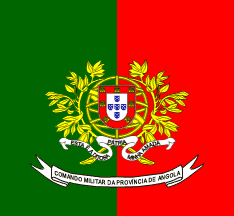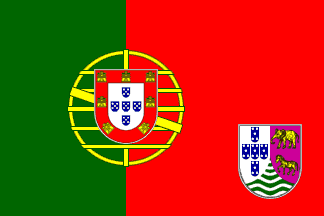 image by
António Martins, 17 June 2009
image by
António Martins, 17 June 2009
Last modified: 2016-08-18 by bruce berry
Keywords: portugal | welwitschia | overseas province |
Links: FOTW homepage |
search |
disclaimer and copyright |
write us |
mirrors
Angola was divided into two colonies. In the 1920s stamps were issued
separately for Angola and for Portuguese Congo (this last colony consisting
of Cabinda and Zaïre provinces, Zaïre lying to the south of the
Congo River mouth). The colony of Congo Portuguesa would seem to have been
an attempt to revive the BaKongo state - I see you illustrate a flag for
Kakongo,
although it is not surprising that you have no illustrations of flags for
earlier states of the BaKongo.
Mike Oettle, 20 Dec 2001
![[Angola - Portuguese General Army Command]](../images/a/ao^pt.gif) image
by António Martins, 21 April 1998
image
by António Martins, 21 April 1998
The General Army Command of Angola (Comando Geral Militar de Angola)
used the Welwitschia mirabilis (which grows in Namibia and
southern
Angola) as the main charge of its coat of arms instead of the
1935 colonial coat of arms sinister mantel, like the commands of the other
former Portuguese colonies of Mozambique,
São
Tomé and Principe, [Portuguese]
Guinea and
Cape Verde. This is a
putative banner of arms of the Army Command.
António Martins, 21 April 1998
 image by
António Martins, 17 June 2009
image by
António Martins, 17 June 2009
The Regimental Colour of the Provincial Military Command in Angola was a regular Portuguese military colour, with the addition of a white scroll under the emblem containing the name of the Unit. In this case, it reads «Comando Militar da Província de Angola», in embroidered capitals, the middle word "da" in half size.
The Provincial Military Command was in existence between 1961 until Angola's
independence in November1975 and its main purpose was to fight the colonial war.
António Martins, 17 June 2009
 image
by
António Martíns-Tuválkin, 01 July 2016
image
by
António Martíns-Tuválkin, 01 July 2016The heraldist F. P. de Almeida Langhans published on p. 67 of his Armorial do Ultramar Português (Lisbon, 1965) [lgh65] a general model for the Portuguese overseas "provinces" flags. This was the Portuguese national flag defaced with the shield of the lesser arms of each province centered in the lower fly quarter of the red field. This proposal was approved in 1967, but never came into effect.
1935.gif) image by
António Martíns-Tuválkin, 01 July 2016
image by
António Martíns-Tuválkin, 01 July 2016
The colonial arms, decreed on 08 June 1935 had a shield
of the same pattern, tierced in mantel, the dexter silver, five escutcheons
in saltire, each charged with five bezants, gold, in cross; and the point
silver, five waves green. The remaining sinister mantel had some local
emblem: Angola: Purple, an elephant and a zebra, both proper, passant dexter,
per pale.
Antonio Martíns, 08 July 1997, corrected 14 September
1997